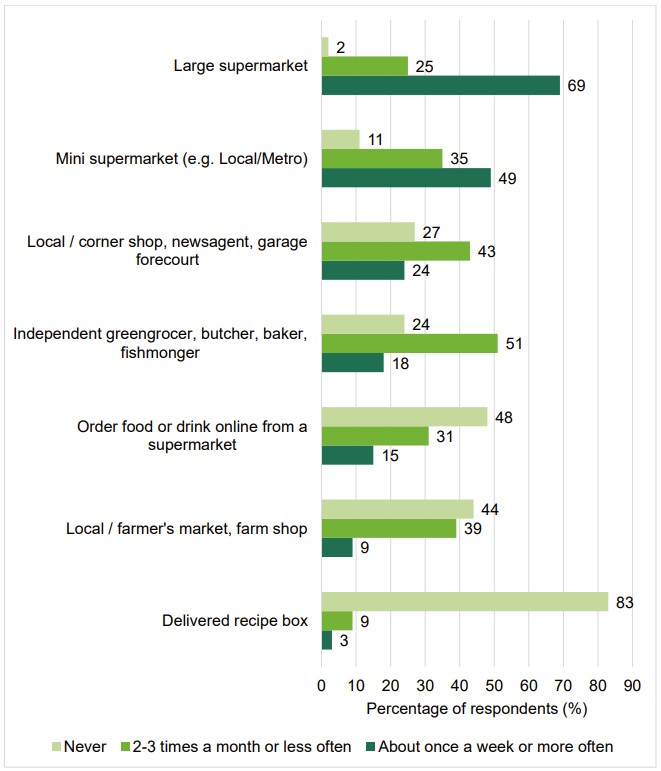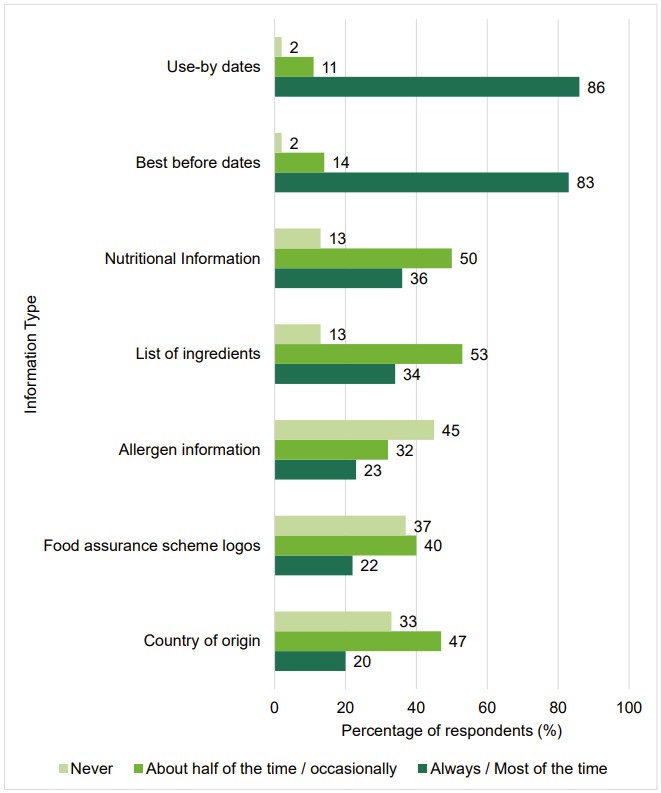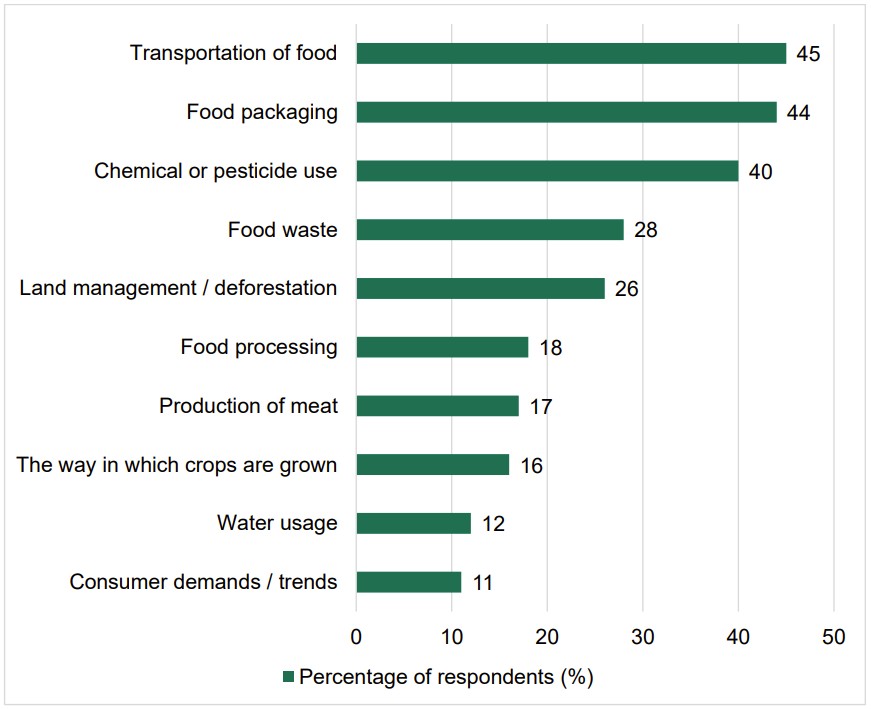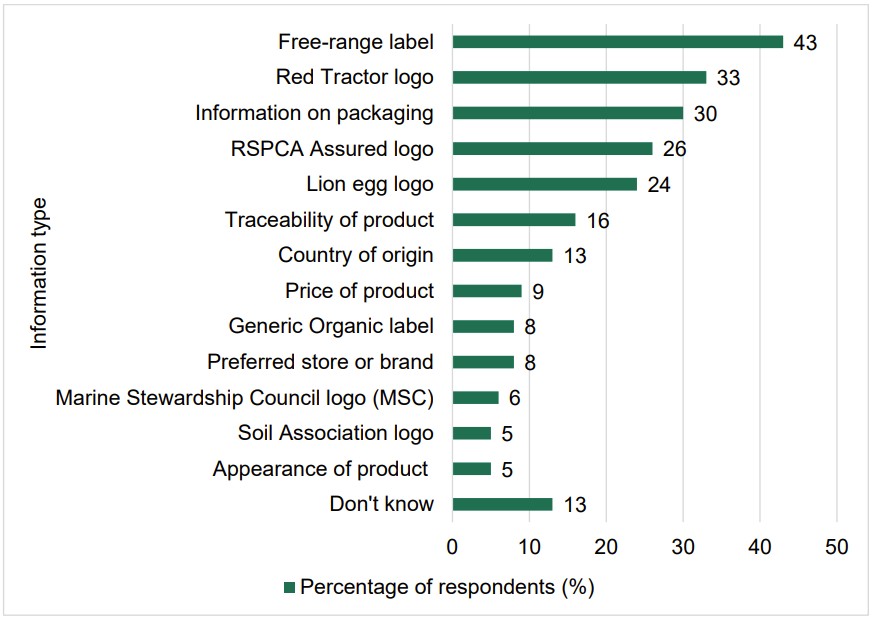F&Y2 Wave 9, Chapter 4: Food shopping and labelling
This chapter provides an overview of food purchasing, what respondents look for when they are shopping, and confidence in allergen labelling. Defra co-funded questions in this chapter, which relate to food provenance, sustainability, and animal welfare.
Introduction
The remit of food labelling is held by multiple bodies that differ between England, Wales and Northern Ireland.
The FSA is responsible for aspects of food labelling which relate to food safety and allergens in England, Wales and Northern Ireland. In addition, the FSA in Wales is responsible for food labelling related to food composition standards and country of origin. The FSA in Northern Ireland is responsible for food labelling related to food composition standards, country of origin and nutrition (footnote 1).
The Department for Environment, Food and Rural Affairs (Defra) plays a major role in food production and is responsible for aspects of food labelling such as composition and provenance.
This chapter provides an overview of food purchasing, what respondents look for when they are shopping, and confidence in allergen labelling. Defra co-funded questions in this chapter which relate to food provenance, sustainability, and animal welfare.
Where do respondents buy food from?
Respondents were asked to indicate where and how frequently they buy food (Figure 12) (footnote 2). Supermarkets were used most frequently by respondents with 69% of respondents buying food from a large supermarket about once a week or more often, and 49% buying food from a mini supermarket once a week or more often.
Independent shops (greengrocers, butchers, bakers, fishmongers), local/corner shops, newsagent or garage forecourt, and local/farmers’ markets or farm shops were used less frequently, with the majority of respondents buying food from these 2-3 times a month or less often (51%, 43% and 39% respectively).
Respondents were least likely to report using online supermarkets or recipe boxes with the majority of respondents reporting that they had never used these (48% and 83% respectively) (Figure 12).
Figure 12. Where respondents buy food from

Source: Food and You 2: Wave 9
What do respondents look for when buying food?
Respondents were asked to indicate what information they check when buying food (Figure 13) (footnote 3). Respondents were most likely to check use-by (86%) or best before dates (83%) with the majority of respondents doing this 'always' or 'most of the time' when they bought food. Around half of respondents reported checking the list of ingredients (53%), nutritional information (50%) and country of origin (47%) about half of the time or occasionally. Four in ten respondents (40%) reported checking food assurance logos about half of the time or occasionally.
Allergen information was least often checked by respondents, with 45% reporting they never checked this. However, respondents who have a food allergy only (50%)* or an intolerance only (48%) were more likely to check allergen information ‘always’ or ‘most of the time’ when food shopping compared to those without a food hypersensitivity (17%).
Figure 13. What information respondents look for when buying food

Source: Food and You 2: Wave 9
Respondents were asked what they consider to be most important when choosing which food to buy from a list of options (footnote 4). The most frequently selected attribute was price/value for money (58%), followed by quality (39%), freshness (30%), and use-by dates and/or how long it will keep for (26%). Around two in ten selected taste (21%) and healthiness (23%). Around one in ten selected ingredients (12%), chose what their household or children wanted (12%), selected farming methods (e.g. organic or free range) (9%) and convivence/how easy it is to prepare (9%).
When asked what information is used to judge the quality of food from a list of options, around half of respondents reported that they used freshness (51%), 44% used taste, and 43% used appearance to judge food quality (footnote 5). Fewer respondents reported that they used the ingredients (31%), price (28%), brand (25%), animal welfare (16%) and country of origin (12%) to judge food quality. Assurance schemes (10%), environmental impact (6%) and convenience (3%) were the least frequently reported sources of information to judge food quality.
Views on animal welfare, food and drink provenance and the environmental impact of food
Respondents were asked their views on animal welfare, food and drink provenance and the environmental impact of food (footnote 6). Most respondents reported that it was important for them to buy meat, eggs and dairy which are produced with high standards of animal welfare (85%) and to buy food which has a low environmental impact (76%). Whilst 68% thought it was important to buy food produced in Britain, only half of respondents (50%) thought it was important to buy drink produced in Britain.
Respondents were asked how frequently they check for information about the environmental impact and animal welfare of food when shopping (footnote 7). While almost four in ten respondents (38%) reported that they check for information about animal welfare when purchasing food ‘always’ or ‘most of the time’, only a quarter of respondents (24%) reported that they check for information about the environmental impact of food ‘always’ or ‘most of the time’.
Respondents were asked to indicate how often, where possible, they buy food which was produced in Britain, has animal welfare information or which had a low environmental impact. Around six in ten respondents (59%) often (‘always’ or ‘most of the time’) buy meat, eggs and dairy which has information on animal welfare, half (52%) often buy food produced in Britain, and 36% often buy food which has a low environmental impact (footnote 8). Respondents were asked to what extent they agree that different food products provide enough information on animal welfare, environmental impact and country of origin (footnote 9). Almost half of respondents (46%) thought that food products show enough information about their country of origin, around a third of respondents (35%) thought that meat, eggs, and dairy products show enough information about animal welfare, and two in ten (20%) thought food products show enough information about their environmental impact.
Respondents were asked to what extent they agree that different food products provide enough information on animal welfare, environmental impact and country of origin. Almost half of respondents (46%) thought that food products show enough information about their country of origin, around a third of respondents (35%) thought that meat, eggs, and dairy products show enough information about animal welfare, and two in ten (20%) thought food products show enough information about their environmental impact.
Respondents were asked, from a list of options, what they think contributes most to the environmental impact of food (Figure 14) (footnote 10). The factors thought to have most environmental impact were the transportation of food (45%) and food packaging (44%). The use of chemicals and pesticides (40%), food waste (28%) and land management and/or deforestation (26%) were also considered as contributors to the environmental impact of food.
Figure 14. Factors thought to contribute most to the environmental impact of food

Source: Food and You 2: Wave 9
When respondents were asked, from a list of options, what would indicate whether a product containing meat, eggs or dairy had been produced with high standards of animal welfare, the most common indicator selected was a free-range label (43%) (Figure 15) (footnote 11). Other commonly selected indicators of animal welfare standards were the Red Tractor logo (33%), information on packaging (30%), the RSPCA Assured logo (26%) and the Lion Egg logo (24%). Around one in ten (13%) reported that they do not know what would indicate whether a product containing meat, eggs or dairy had been produced with high standards of animal welfare.
Figure 15. What would indicate high animal welfare standards of meat, eggs, and dairy products to respondents

Source: Food and You 2: Wave 9
Confidence in allergen labelling (footnote 12)
Food hypersensitivity is a term that refers to a bad or unpleasant physical reaction which occurs as a result of consuming a specific food. There are different types of food hypersensitivity including, food allergy, food intolerance and coeliac disease (footnote 13).
The FSA provides guidance for food businesses on providing allergen information to their customers. By law (footnote 14), food businesses in the UK must inform customers if they use any of the 14 most potent and prevalent allergens in the food and drink they provide (footnote 15).
The allergen labelling required differs depending on how food is being sold and the type of food being sold. If food is sold online, allergen information should be available to a customer before the purchase of the food is completed and when the food is delivered (footnote 16).
Respondents who go food shopping and consider the dietary requirements (allergy/intolerance) of themselves or someone else in the household when shopping were asked how confident they were that the information provided on food labelling allows them to identify foods that would cause a bad or unpleasant physical reaction (footnote 17). Of those, 84% stated that they were confident (very confident or fairly confident) in the information provided.
The same group of respondents (those who consider the dietary requirements of themselves/someone else in the household when shopping) were asked how confident they were in identifying foods that will cause a bad or unpleasant physical reaction when buying foods which are sold loose, such as at a bakery or deli-counter (footnote 18). Respondents who bought food loose were more confident in identifying these foods from supermarkets in-store (72%), from online supermarkets (62%), and when shopping at independent food shops (61%) compared to buying food from food markets or stalls (47%).
-
Nutrition standards and nutrition food labelling is the remit of the Department of Health and Social care in England and the Welsh Government in Wales.
-
Question: How often, if at all, do you…a) shop for food in store at a large supermarket b) shop for food in store at a mini supermarket (e.g., Local/ Metro). c) shop for food at independent greengrocers', butchers', bakers' or fishmongers'. d) shop for food at local/corner shops, newsagents' or garage forecourts. e) get a home delivery from a supermarket. f) shop for food at a local market, farmer's market or farm shop. g) get a recipe box delivered (e.g. Hello Fresh, Gousto). Responses: every day, most days, 2-3 times a week, about once a week, 2-3 times a month, about once a month, less than once a month, never, can’t remember, I don’t do any food shopping. Base= 3530, all online respondents.
-
Question: When shopping for food, how often, if at all, do you check…a) use-by dates. b) best before dates. c) list of ingredients. d) allergen information. e) nutritional information. f) country of origin. g) food assurance scheme logos. Responses: always, most of the time, about half the time, occasionally, never, don’t know. Base= 3304, all online respondents who ever do food shopping. Please note: allergy only base n=95*
-
Question: What is most important to you when you are choosing which foods to buy? Responses: price/value for money, quality, freshness, taste, appearance of food, healthiness, use-by date/how long it will keep for, country of origin, ingredients, that it is ethical or eco-friendly, farming methods for example, organic or free-range farming, how it is made or how it is produced, choice/availability/variety, buying what my household/ children want, trust in supplier, safety of product, convenience/how easy it is to cook or prepare, other, don’t know. Base= 5526, all respondents.
-
Question: What do you use to judge the quality of food? Responses: taste, appearance, country of origin, convenience, ingredients, animal welfare, freshness, assurance schemes, brand, price, environmental impact, other. Base= 5526, all respondents.
-
Question: How important is it to you…a) to buy food that was produced in Britain [if Northern Ireland: UK and Ireland] b) to buy drink that was produced in Britain [if Northern Ireland: UK and Ireland] c) to buy meat, eggs and dairy which are produced with high standards of animal welfare. d) to buy food which has a low environmental impact. Responses: very important, somewhat important, not very important, not at all important, don't know. Base= 5526, all respondents.
-
Question: When purchasing food, how often do you do the following…a) check for information on animal welfare. b) check for information on environmental impact. Responses: always, most of the time, about half the time, occasionally, never, don't know. Base=5157, all online respondents and those answering the England & Wales postal questionnaire.
-
Question: How often do you do the following, where possible? A) Buy food produced in Britain [If Northern Ireland: ‘the UK and Ireland’]? B) Buy meat, eggs and dairy which has information on animal welfare. C) Buy food which has a low environmental impact. Responses: Always, Most of the time, About half the time, Occasionally, Never, Don't know. Base= 5526, all respondents.
-
Question: To what extent do you agree or disagree with the following? a) meat, eggs and dairy products show enough information about animal welfare. b) food products show enough information about their environmental impact c) food products show enough information about their country of origin. Responses: strongly agree, agree, neither agree nor disagree, disagree, strongly disagree, don't know. Base= 4634, all online respondents and those answering the version A postal questionnaire.
-
Question: What do you think contributes to the environmental impact of food? Responses: food packaging, chemicals or pesticides, transportation of food, land management/deforestation, food waste, production of meat, the way in which crops are grown, food processing, consumer demand/trends, water usage, other, don’t know. Base= 5526, all respondents.
-
Question: What would indicate to you whether a product containing meat, eggs or dairy had been produced with high standards of animal welfare? Responses: freerange label, information on packaging, country of origin, traceability of product, preferred store or brand, appearance of product, price of product, generic organic label, Red Tractor logo, RSPCA assured logo, Lion egg logo, Soil Association logo, Marine Stewardship (MSC) logo, other certification/logo [open text], other [open text], don’t know. Base= 5526, all respondents.
-
Other questions on food hypersensitivities are reported in Chapter 5 (Online Platforms). Please note that not all questions are included in this report.
-
FSA Explains: Food hypersensitivities. Overview: Food Allergy, NHS. Food Intolerance, NHS. Overview: Coeliac disease, NHS.
-
42 Regulation (EU) No 1169/2011 of the European Parliament and of the Council of 25 October 2011.
-
Allergens: celery, cereals containing gluten (such as barley and oats), crustaceans (such as prawns, crabs and lobsters), eggs, fish, lupin, milk, molluscs (such as mussels and oysters), mustard, peanuts, sesame, soybeans, sulphur dioxide and sulphites and tree nuts (such as almonds, hazelnuts, walnuts, brazil nuts, cashews, pecans, pistachios and macadamia nuts).
-
Question: How confident are you that the information provided on food labels allows you to identify foods that will cause you, or another member of your household, a bad or unpleasant physical reaction? Responses: very confident, fairly confident, not very confident, not at all confident, it varies from place to place, don't know. Base= 2072, all online respondents and those answering version A of the postal questionnaire who consider the dietary requirements (allergy or intolerance) of themselves/someone else in the household when shopping.
-
Question: When buying food that is sold loose (e.g. at a bakery or deli counter), how confident are you that you can identify foods that will cause you or another member of your household a bad or unpleasant physical reaction? Consider food sold loose from the following sources…a) supermarkets in store. b) supermarkets online. c) independent food shops. d) food markets/stalls. Responses: very confident, fairly confident, not very confident, not at all confident, it varies from place to place, don't know. Base a=1552, b=1164, c=1368, d=1354, all online respondents who consider the dietary requirements (allergy or intolerance) of themselves/someone else in the household when shopping, excluding `I don't buy food from here'/`I don't buy food sold loose'.